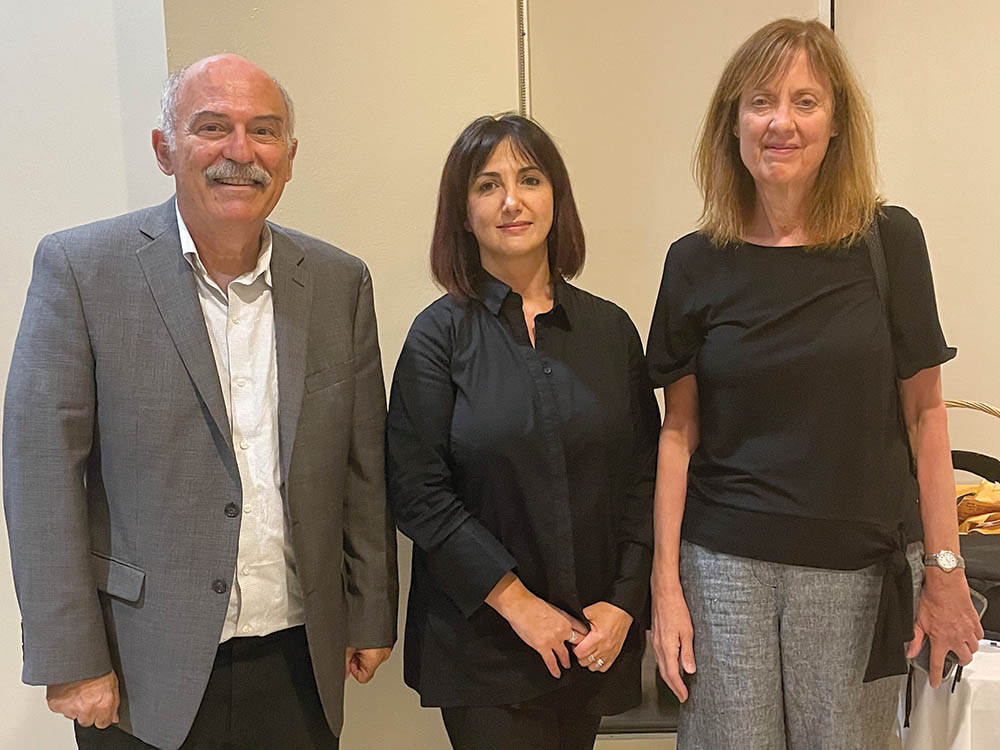Alfred Hitchcock once famously claimed: “In feature films the director is God; in documentary films, God is the director.”
Director Inna Sahakyan of Bars Media referenced Hitchcock’s words when introducing her New York Times Critic’s Pick documentary “Aurora’s Sunrise” at the Fresno premier screening, which took place on Friday, September 1, before an audience of more two hundred and fifty people. “Aurora’s Sunrise” was featured as part of the weekly CineCulture program at Fresno State and co-sponsored by the Armenian Studies Program. These two on-campus programs collaborate to screen various films in an effort to “create bridges of cultural understanding.”
The event was organized and hosted in partnership with Bars Media and the Zoryan Institute. The documentary was created by Bars Media Studio (Armenia) in co-production with Gebrueder Beetz Filmproduktion (Germany) and Artbox Laisvalaikio Klubas (Lithuania). The film was made possible by the academic contri-bution of the Zoryan Institute and is based on its Oral History Archive.
“Aurora’s Sunrise” is a documentary filmed based on the first film of the Armenian Genocide in 1919 titled “Auction of Souls.” The silent film featured Arshaluys “Aurora” Mardiganian in an interpretation of her own Genocide experience, while Sahakyan’s documentary delves into the true story of Mardiganian’s survival and arrival to America.
The evening began with a short informational video provided by the Zoryan Institute depicting the realities of genocide and imposed censorship throughout the world. The Zoryan Institute in Contemporary Armenian Research and Documentation was founded in 1982 and “serves the cause of scholarship and public awareness relating to issue of human rights, genocide, and diaspora-homeland relations.” They work to bring awareness to the Armenian Genocide through oral history interviews with Genocide survivors, which contributed to the development of “Aurora’s Sunrise.”
“Aurora’s Sunrise” not only brought attention to the Armenian Genocide, but did so in an artistic and heart-gripping manner. The film explored the “nature of humanity” through the use of innovative technology and personal accounts. According to Sahakyan, “The balance of heavy, light, and indirect mediums spoke to all audiences and contributed to the film’s appeal.” The production team “directed from a color palette,” one that paralleled the events portrayed. The colors and mediums connected memories from the past and present, intertwining symbolism, history, and personal experience.
Red was a prominent color throughout the film. In the bright memories of Aurora’s childhood, red is represented in the colored silks her father made and is an homage to her family roots in silk making. Later in the film, red is used to blatantly depict bloodshed. When Aurora arrives in America and makes her film debut in “Auction of Souls,” she is seen walking on the red carpet, symbolizing the glamor of the American life she became engulfed in. Each of these scenes display the complexity of the production in its ability to take a single color and use it to connect Aurora’s memories of nostalgia, pain, and new beginnings.
Along with the color palette, the mixed mediums within the documentary also provide insight into the context of each scene. Sahakyan recalled that it was an “early choice” to use animation in the film. Despite the time-consuming manner of animation, the production team firmly embraced the concept of utilizing a softer method to communicate harsher events. In order to maintain mass appeal, it was important to not only depict truth, but to also maintain the attention of audiences.
The production team al-so obtained the remaining eighteen minutes of footage from “Auction of Souls” and integrated scenes from the film into their documentary. They utilized these clips to not only present the original film, but to compare it to Mardiganian’s true experience through her interviews in the documentary. Mardiganian mentioned that some of the storylines were concocted and brutalities were minimized in “Auction of Souls” that are different than her actual experience in surviving the genocide.
“Auction of Souls” fabricated a love story to incorporate emotional intricacies into the film and depicted censored versions of the true horrors the Armenian people faced. These were creative choices done by Hollywood to ensure the film appealed to all audiences, and Mardiganian noted how the film soon became about money and publicity rather than the cause behind its success. Her testimony coupled with the original footage speaks about truth and legitimacy, and the documentary serves as an important modern method in increasing Genocide awareness.
After eight years of work, “Aurora’s Sunrise” was finally produced. It not only recounts the personal story of Aurora’s reconciliation with her past, but it is an important historical documentary that highlights the realities of genocide. With its captivating storyline, mediums, and music, “Aurora’s Sunrise” marked Armenia’s official entry to the 95th Academy Awards and will continue to have screenings throughout the world.




